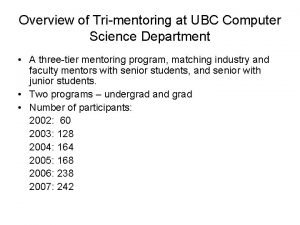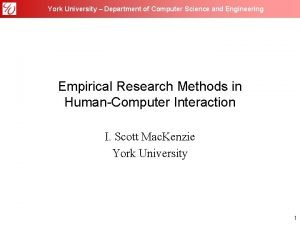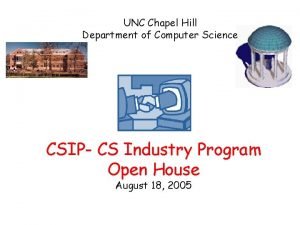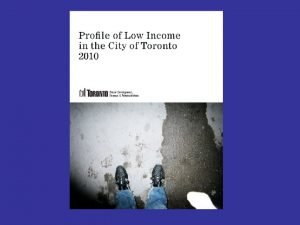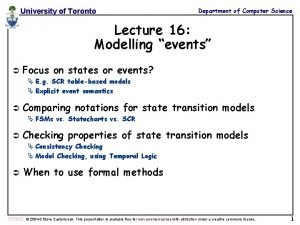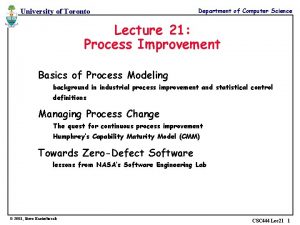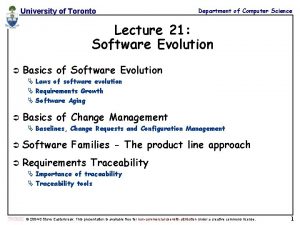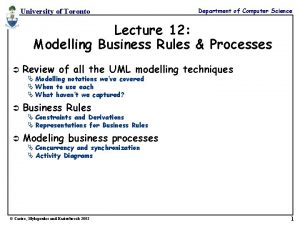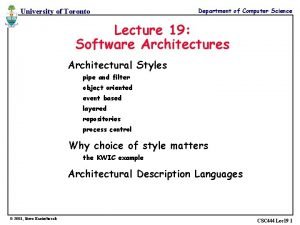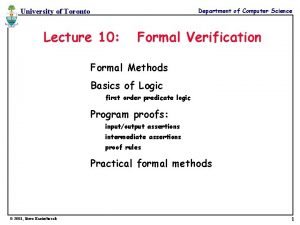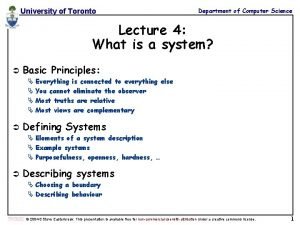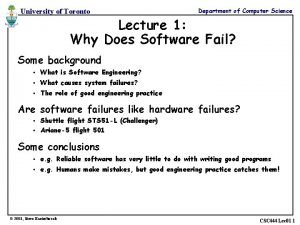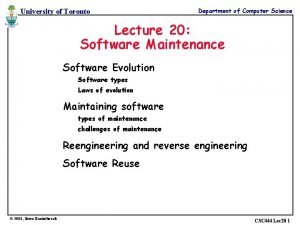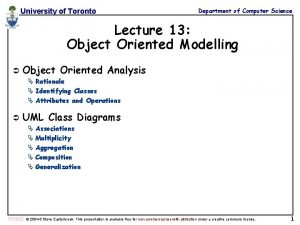University of Toronto Department of Computer Science Lecture
















- Slides: 16

University of Toronto Department of Computer Science Lecture 23: Software Architectures Ü Architectural Styles Ä Pipe and filter Ä Object oriented: Ø Client-Server; Object Broker Ä Event based Ä Layered: Ø Designing Layered Architectures Ä Repositories: Ø Blackboard, MVC Ä Process control © Easterbrook 2004 1

Department of Computer Science University of Toronto Pipe-and-filter Source: Adapted from Shaw & Garlan 1996, p 21 -2. See also van Vliet, 1999 Pp 266 -7 and p 279 filter pipe pipe Ü pipe filter pipe Examples: Ä UNIX shell commands Ä Compilers: Ø Lexical Analysis -> parsing -> semantic analysis -> code generation Ä Signal Processing Ü Interesting properties: Ä filters don’t need to know anything about what they are connected to Ä filters can be implemented in parallel Ä behaviour of the system is the composition of behaviour of the filters Ø specialized analysis such as throughput and deadlock analysis is possible © Easterbrook 2004 2

Department of Computer Science University of Toronto Object Oriented Architectures Source: Adapted from Shaw & Garlan 1996, p 22 -3. method invocation object Examples: object method invocation Ü object method invocation Ä abstract data types Ü Interesting properties Ä data hiding (internal data representations are not visible to clients) Ä can decompose problems into sets of interacting agents Ä can be multi-threaded or single thread Ü Disadvantages Ä objects must know the identity of objects they wish to interact with © Easterbrook 2004 3

Department of Computer Science University of Toronto Variant 1: Client Server client method invocation Server Ü method invocation Interesting properties Ä Is a special case of the previous pattern object oriented architecture Ä Clients do not need to know about one another Ü Disadvantages Ä Client objects must know the identity of the server © Easterbrook 2004 4

Department of Computer Science University of Toronto Variant 2: Object Brokers client broker server client Ü Interesting properties Ä Adds a broker between the clients and servers Ä Clients no longer need to know which server they are using Ä Can have many brokers, many servers. Ü Disadvantages Ä Broker can become a bottleneck Ä Degraded performance © Easterbrook 2004 5

University of Toronto Department of Computer Science Broker Architecture Example © Easterbrook 2004 6

Department of Computer Science University of Toronto Event based (implicit invocation) Source: Adapted from Shaw & Garlan 1996, p 23 -4. See also van Vliet, 1999 Pp 264 -5 and p 278 announce event agent broadcast medium agent Ü Examples listen for event announce event agent Ä debugging systems (listen for particular breakpoints) Ä database management systems (for data integrity checking) Ä graphical user interfaces Ü Interesting properties Ä announcers of events don’t need to know who will handle the event Ä Supports re-use, and evolution of systems (add new agents easily) Ü Disadvantages Ä Components have no control over ordering of computations © Easterbrook 2004 7

Department of Computer Science University of Toronto Layered Systems Source: Adapted from Shaw & Garlan 1996, p 25. See also van Vliet, 1999, p 281. application layer utilities users Ü kernal Examples Ä Operating Systems Ä communication protocols Ü Interesting properties Ä Support increasing levels of abstraction during design Ä Support enhancement (add functionality) and re-use Ä can define standard layer interfaces Ü Disadvantages Ä May not be able to identify (clean) layers © Easterbrook 2004 8

Department of Computer Science University of Toronto Variant: 3 -layer data access Presentation layer Appl’n Views Java AWT Application Logic layer Business logic Contol objects File Mgmnt Query Engine © Easterbrook 2004 DBMS Storage layer 9

University of Toronto Department of Computer Science Open vs. Closed Layered Architecture Ü closed architecture Ä each layer only uses services of the layer immediately below; Ä Minimizes dependencies between layers and reduces the impact of a change. Layer N-1 Layer 2 Layer 1 Ü open architecture Ä a layer can use services from any lower layer. Ä More compact code, as the services of lower layers can be accessed directly Ä Breaks the encapsulation of layers, so increase dependencies between layers Layer N-1 Layer 2 Layer 1 © Easterbrook 2004 10

Department of Computer Science University of Toronto How many layers? Ü Ä application layer Ä database layer Ä e. g. simple client-server model Ü Application (client) 2 -layers: 3 -layers: Database (server) Presentation layer (user interface) Business Logic Ä separate out the business logic Øhelps to make both user interface and database layers modifiable Ü 4 -layers: Ä Separates applications from the domain entities that they use: Database Presentation layer (user interface) Applications Øboundary classes in presentation layer Øcontrol classes in application layer Øentity classes in domain layer Ü Domain Entities Database Partitioned 4 -layers Ä identify separate applications UI 1 UI 2 UI 3 UI 4 App 1 App 2 App 3 App 4 Domain Entities Database © Easterbrook 2004 11

Department of Computer Science University of Toronto Repositories Source: Adapted from Shaw & Garlan 1996, p 26 -7. See also van Vliet, 1999, p 280 agent Ü Examples blackboard (shared data) agent Ä databases Ä blackboard expert systems Ä programming environments Ü Interesting properties Ä can choose where the locus of control is (agents, blackboard, both) Ä reduce the need to duplicate complex data Ü Disadvantages Ä blackboard becomes a bottleneck © Easterbrook 2004 12

Department of Computer Science University of Toronto Variant: Model-View-Controller propagate update controller update access model controller access view Ü propagate Properties Ä One central model, many views (viewers) Ä Each view has an associated controller Ä The controller handles updates from the user of the view Ä Changes to the model are propagated to all the views © Easterbrook 2004 13

University of Toronto Department of Computer Science Model View Controller Example © Easterbrook 2004 14

University of Toronto Department of Computer Science MVC Component Interaction © Easterbrook 2004 15

Department of Computer Science University of Toronto Process Control Source: Adapted from Shaw & Garlan 1996, p 27 -31. input variables control parameters Ü controller manipulated variables Examples s or s en s process actuators controlled variables Ä aircraft/spacecraft flight control systems Ä controllers for industrial production lines, power stations, etc. Ä chemical engineering Ü Interesting properties Ä separates control policy from the controlled process Ä handles real-time, reactive computations Ü Disadvantages Ä Difficult to specify the timing characteristics and response to disturbances © Easterbrook 2004 16
 Computer science department columbia
Computer science department columbia University of toronto anthropology phd
University of toronto anthropology phd Meng computer science ucl
Meng computer science ucl Northwestern computer science department
Northwestern computer science department Computer science department rutgers
Computer science department rutgers Stanford computer science department
Stanford computer science department Florida state university cs faculty
Florida state university cs faculty Ubc computer science department
Ubc computer science department Bhargavi goswami
Bhargavi goswami 01:640:244 lecture notes - lecture 15: plat, idah, farad
01:640:244 lecture notes - lecture 15: plat, idah, farad Subject science
Subject science University of phoenix computer science
University of phoenix computer science University of bridgeport engineering
University of bridgeport engineering Computer science tutor bridgeport
Computer science tutor bridgeport Yonsei syllabus
Yonsei syllabus York university computer science
York university computer science University of north carolina chapel hill computer science
University of north carolina chapel hill computer science







